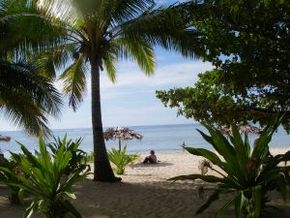Fiji Travel Guide
Fiji is a Melanesian state comprising over 400 islands, only about a quarter of which are inhabited. Fiji fits perfectly into the stereotype of a tropical paradise. The volcanic mountains that gave birth to the islets are surrounded by verdant forests and pearly beaches washed by clear waters and beautiful coral reefs. Being stranded for a few weeks on one of the tiny islands is probably the dream of many adventurous tourists, but you can have just as much fun on any of the more populated islands of the country. The low prices and lack of diseases make Fiji a dream come true for any beach appassionato, as well as for those who want to cut ties for a while with their hectic day to day lives. This Fiji Travel Guide is a short introduction on the archipelago, for those who are interested in visiting this tropical paradise.
Fiji Travel Guide - Geography and Climate
The largest island of the archipelago is Viti Levu, which covers over 50% of Fiji’s total area. Most of the country’s population lives in the two cities on the island: Suva, the capital, and Lautoka, as well as larger towns such as Nadi and Nasinu. All the islands are covered with thick tropical forests, and weather can be quite rainy during certain seasons. The geography of Fiji is very diverse: high mountains traversed by deep valleys, forests and pastures, and, of course, sandy beaches.
Remote villages are scattered on the largest islands, but although public transport is not very well developed, there are accessible trails that will lead you to them. Transport between the islands is readily available in the guise of daily ferries.
Fiji Travel Guide - Culture and Cuisine
Fiji’s culture is a melting pot of Indian, Chinese and European elements. Indigenous Fijians represent quite a large portion of the population, and their way of life and traditions are still very much alive today. The external influences of other people who have come in contact or settled in Fiji have harmoniously mingled with the Fijian stock, giving birth to a culture unique in entire Polynesia.
Traditional crafts, music and dance are Fiji’s pride and joy. Exquisite pottery is being produced on Kadavu Island, canoes are built on all inhabited islands where fishing is a staple occupation, and the meke, an art that combines music, dance and storytelling is performed during each festival.
Before the colonization of the islands, the Fijian diet consisted of various vegetables and meats seasoned with enticing spices and cooked over wood fires. People still use the traditional cooking method: the food is wrapped in banana leaves and cooked in earth ovens. More elaborate dishes have been created during colonial times. This Fiji Travel Guide warmly recommends the delicious Kokoda, steamed fish with lime and coconut cream, served mainly at festivals.
Recent Travel Guides from Fiji
Don’t you dare avoiding a trip to Suva if you are a nightlife addict! Here you will experience one of the most exciting white nights you ever had in your entire life. Suava Nightlife, with its many bars and restaurants waiting for you to pass their threshold, expecting their clients with the best food ever, will not disappoint you. The most famous restaurant is Daikoku.... Read more »
Suva, Fiji
When thinking of Fiji, most people imagine a tropical paradise, and it is so. The Fiji archipelago in the Pacific Ocean, with its more than 300 islands, is a paradise for any holiday maker looking for an exotic place where they can relax and have fun. Suva is the capital of Fiji, and it is located on the island of Viti Revu, the country’s largest and most populous island.... Read more »
Nadi, Fiji
Nadi is the third largest city in Fiji and is situated on the western part of the island of Viti Levu. The population of Nadi was estimated to be around 42,284 in the year 2007. Nadi is inhabited by a large number of Indians and Fijians and many multiracial tourists as well. The main industry is sugar cane production and tourism. Therefore, the city has the highest number of hotels in Fiji.... Read more »


